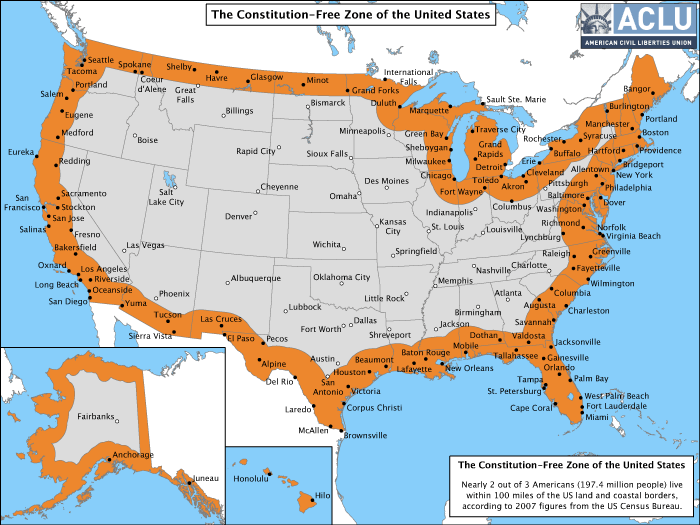 Did you know that Cochise County and even Tucson is a land with a different interpretation of the Bill of Rights than the rest of the United States?
Did you know that Cochise County and even Tucson is a land with a different interpretation of the Bill of Rights than the rest of the United States?
Within 100 miles of the border, the federal government has assumed extraordinary power to search and seize individuals without warrants, or probable cause.
Are you aware that nearly 2/3 of the entire US population (197.4 million people) live within 100 miles of the US land and coastal borders?
Here are facts from the ACLU concerning your rights along the border:
Fact Sheet on U.S. “Constitution-Free Zone”
October 22, 2008
The problem
Normally under the Fourth Amendment of the U.S. Constitution, the American people are not generally subject to random and arbitrary stops and searches.
The border, however, has always been an exception. There, the longstanding view is that the normal rules do not apply. For example the authorities do not need a warrant or probable cause to conduct a “routine search.”
But what is “the border”? According to the government, it is a 100-mile wide strip that wraps around the “external boundary” of the United States.
As a result of this claimed authority, individuals who are far away from the border, American citizens traveling from one place in America to another, are being stopped and harassed in ways that our Constitution does not permit.
Border Patrol has been setting up checkpoints inland — on highways in states such as California, Texas and Arizona, and at ferry terminals in Washington State. Typically, the agents ask drivers and passengers about their citizenship. Unfortunately, our courts so far have permitted these kinds of checkpoints – legally speaking, they are “administrative” stops that are permitted only for the specific purpose of protecting the nation’s borders. They cannot become general drug-search or other law enforcement efforts.
However, these stops by Border Patrol agents are not remaining confined to that border security purpose. On the roads of California and elsewhere in the nation – places far removed from the actual border – agents are stopping, interrogating, and searching Americans on an everyday basis with absolutely no suspicion of wrongdoing.
The bottom line is that the extraordinary authorities that the government possesses at the border are spilling into regular American streets.
Much of U.S. population affected
Many Americans and Washington policymakers believe that this is a problem confined to the San Diego-Tijuana border or the dusty sands of Arizona or Texas, but these powers stretch far inland across the United States.
To calculate what proportion of the U.S. population is affected by these powers, the ACLU created a map and spreadsheet showing the population and population centers that lie within 100 miles of any “external boundary” of the United States.
The population estimates were calculated by examining the most recent US census numbers for all counties within 100 miles of these borders. Using numbers from the Population Distribution Branch of the US Census Bureau, we were able to estimate both the total number and a state-by-state population breakdown. The custom map was created with help from a map expert at World Sites Atlas.
What we found is that fully TWO-THIRDS of the United States’ population lives within this Constitution-free or Constitution-lite Zone. That’s 197.4 million people who live within 100 miles of the US land and coastal borders.
Nine of the top 10 largest metropolitan areas as determined by the 2000 census, fall within the Constitution-free Zone. (The only exception is #9, Dallas-Fort Worth.) Some states are considered to lie completely within the zone: Connecticut, Delaware, Florida, Hawaii, Maine, Massachusetts, Michigan, New Hampshire, New Jersey, New York, Rhode Island and Vermont.
Part of a broader problem
The spread of border-search powers inland is part of a broad expansion of border powers with the potential to affect the lives of ordinary Americans who have never left their own country.
It coincides with the development of numerous border technologies, including watch list and database systems such as the Automated Targeting System (ATS) traveler risk assessment program, identity and tracking systems such as electronic (RFID) passports, the Western Hemisphere Travel Initiative (WHTI), and intrusive technological schemes such as the Secure Border Initiative Network (SBINet) or “virtual border fence” and unmanned aerial vehicles (aka “drone aircraft”).
This illegitimate expansion of the extraordinary powers of agents at the border is also part of a general trend we have seen over the past 8 years of an untrammeled, heedless expansion of police and national security powers without regard to the effect on innocent Americans.
This trend is also typical of the Bush Administration’s dragnet approach to law enforcement and national security. Instead of intelligent, competent, targeted efforts to stop terrorism, illegal immigration, and other crimes, what we have been seeing in area after area is an approach that turns us all into suspects. This approach seeks to sift through the entire U.S. population in the hopes of encountering the rare individual whom the authorities have a legitimate interest in.
If the current generation of Americans does not challenge this creeping (and sometimes galloping) expansion of federal powers over the individual through the rationale of “border protection,” we are not doing our part to keep alive the rights and freedoms that we inherited, and will soon find that we have lost some or all of their right to go about their business, and travel around inside their own country, without interference from the authorities.
Published on American Civil Liberties Union (https://www.aclu.org)
Source URL: https://www.aclu.org/technology-and-liberty/fact-sheet-us-constitution-free-zone
